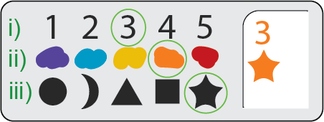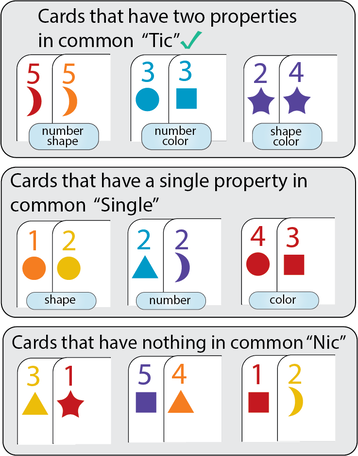I have about 500 tabletop games in my collection and most of them have one, maybe two ways to play them. You typically buy a game, open the box, and cram to read rules that will persist from game to game. Yes, I’m well aware of games like “Fluxx” where the rules are constantly changing. I’m also aware that some folks prefer to spend their afternoons not with a bulky Gloomhaven box but a small deck of fifty-two playing cards. TIC (Two In Common) Playing Cards are more similar to the latter in the sense that you’ll have multiple games to play in the convenience of a small box. Before we begin I’m required by FCC Regulations to note that I was paid to cover this game, but any and all opinions remain my own.
By design, a box of TIC Playing Cards contains a total of 125 cards. There are five different numbers, colors, and shapes unlike a deck of regular playing cards which only features numbers and suits. The below picture illustrates the various combinations available (5 x 5 x 5 = 125).

Important concepts to keep in mind:
When cards have two properties in common they are said to “Tic”
When cards have a single property in common they “Single” or “Sic”.
When cards have nothing in common they are said to “Nic”.

Per the official website, there are a number of easy, medium, and difficult games to play with this deck. To keep this article at a respectable length I’ll opt to cover only one or two of them and the rest you can discover on your own.
Time’s a Ticking (2-5 Players, Ages 7+, Average Play Time = 10 Minutes)
To set up, the deck of cards will be shuffled and five cards are dealt face-up onto the middle of the table within reach of all players. The rest of the cards are distributed evenly among all players. Any extras are put off to the side, not to be used that game.
There are no player turns in “Time’s a Ticking”. Instead, the object is to be the first player to get rid of all of the cards in your hand. Players will be able to play cards to one of the five face-up center cards, covering the existing one like a standard discard pile. The catch is that in order to lay a card down in must create a “Tic”. As explained above, a “Tic” is when cards have two properties in common. For example, you could lay a 2-Yellow-Moon on a 4-Yellow-Moon because two of the properties match. A 3-Blue-Star on top of a 3-Red-Star would also work.
In the event that no one can play any more cards, the player with the fewest cards in their hand is the winner. You CAN play cards that aren’t “Tics”, but if you’re caught, you’re out for 5 “Tic” plays…meaning you’ll need to wait for at least five cards to be played before you can begin laying out cards again.
Personal Note: The deck is fairly large. Dividing the cards amongst 2-3 players will result in a relatively large hand. A work-around might be to deal say, 20 cards to each player and remove the rest from the game.
https://www.youtube.com/watch?time_continue=16&v=OOh9_Uhf0Lo&feature=emb_title
—
Tic-a-Long (2-8 Players, Ages 7+, Average Play Time = 5-20 Minutes per Round)
Like “Time’s a Ticking”, the object is to get rid of all of the cards in your hand before anyone else. Each player is dealt eight to ten cards to start, though you can shorten or lengthen the round by dealing fewer/more cards respectively. If you’re playing with younger children for example, you can opt to deal six or seven cards per player. The deck is put into the middle of the table and one card is drawn face-up as a discard pile.
On your turn you’ll try to play cards onto the discard pile, one by one. If you play a “Tic”, you’ll get to go again. If you play a “Single”, meaning only one property matches, then your turn is over. If you can’t play anything, then you’ll draw one from the deck. If you still can’t play, your turn will end. If you end your turn by last playing a card with stars, the opponent who goes next must draw cards from the deck equal to the value listed on the stars card.
A player who has one card in their hand must announce it…if anyone catches them then they’ll be forced to draw two cards. A player’s last card cannot be played as a “Single”…it must be a “Tic” or a “Tic” followed by a “Single”.
https://www.youtube.com/watch?time_continue=147&v=R43tGj20iig&feature=emb_title
—
As mentioned above there’s something to be said for the convenience of having a bunch of games available in the size of a deck of playing cards. “TIC Playing Cards” is a great travel companion…some which can even be played at a restaurant when you’re on the go. Be warned that not all of the games are table space friendly. “Tic Squared”, a game on the medium difficulty page for example, needs a relatively large playing area.
I liked the variety of the different games available, though it’s hard not to notice some similarities between some of these games and other popular ones on the market. For example, “Tic-a-Long” reminded me of “UNO” in that there’s one discard pile and players will be trying to match cards to play them. The stars on the former act like “Draw X” cards on the latter. Not saying “UNO” in the latter penalizes you just like in “Tic-a-Long”, and so on. Had “Tic-a-Long” been the only game advertised I would have called Shenanigans immediately. Luckily, there’s a lot more to “TIC Playing Cards” than meets the eye.
I also liked that some of the games can be played solo. For example, “Gridsy”, a medium difficulty game, tasks the solo player with creating a 4×4 grid by using as few cards from the deck as possible. The multiplayer variant tasks players with being the first to create one. Cards can only be arranged adjacently into the grid if they share a commonality (called “commonness”)…that is, cards next to each other must be a “Single” or “Tic”. A central pool of four cards allows players to swap out their initial starting cards to help them complete their grid. “Gridsy” is simple but thinky and I love games that challenge the mind without blowing it out of the water. If you have more time to kill, “TIC Rummy” (hard difficulty) can take two+ hours to play. Don’t fret, there are hard ones like “Sequences” that have a fifteen minute average play time.
I enjoyed my time with “TIC Playing Cards”. With multiple difficulty modes available that span several ranges of average play time, you’ll find something here for just about anyone. Some games are ideal for travel, others can be played solo, and many will challenge your critical thinking skills. I can see this being great in a classroom (once the COVID lockdown ends), what with various properties on these cards to process at once. My only concern is that there’s no way to distinguish the colors besides their colors. I’m not colorblind, so I don’t know if some colorblind folks will have issues. Perhaps a “.” for red, “..” for orange, and so on, on the corners of the cards, might alleviate that assuming there is an issue. A lot of developers get around the colorblind issue by assigning a unique graphic to each color, but I imagine that would be difficult to do here. There’s also no instruction manual in the physical card box, but the website is listed as is one of those fancy bar code phone reader things.
Possible colorblindness issues aside, this game has a lot going for it. The $10 price tag on Amazon makes it all the more appealing. You’re getting a LOT of bang for buck here and there’s potential for other games to be invented in the future. A game that allows your imagination to be the limit is worth talking about in my book.
—
Final Verdict: 9/10 (Outstanding)
—
